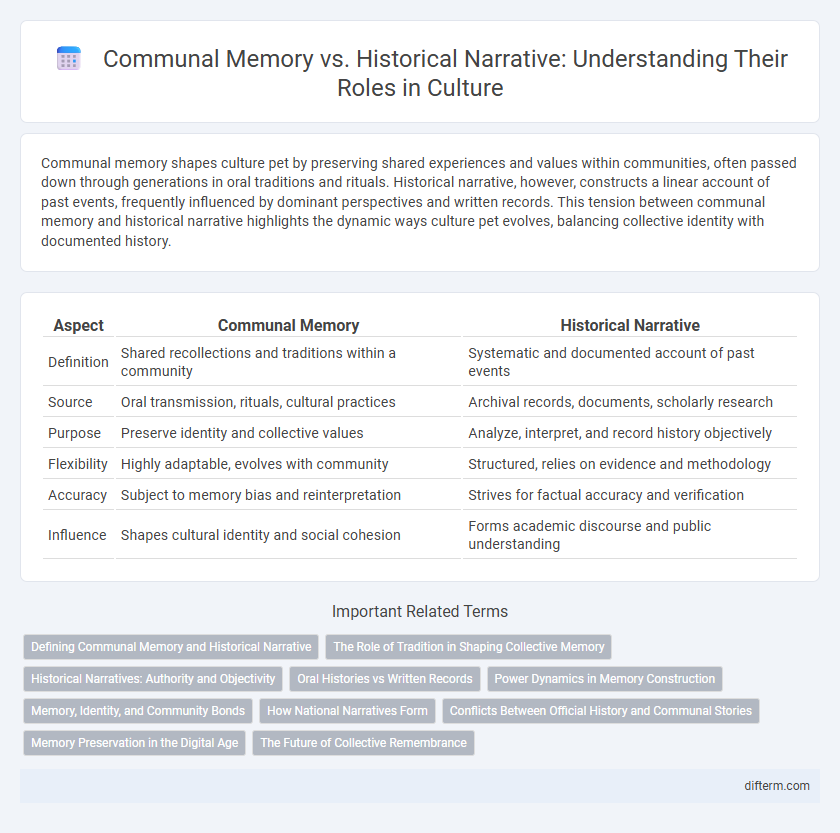Communal memory shapes culture pet by preserving shared experiences and values within communities, often passed down through generations in oral traditions and rituals. Historical narrative, however, constructs a linear account of past events, frequently influenced by dominant perspectives and written records. This tension between communal memory and historical narrative highlights the dynamic ways culture pet evolves, balancing collective identity with documented history.
Table of Comparison
| Aspect | Communal Memory | Historical Narrative |
|---|---|---|
| Definition | Shared recollections and traditions within a community | Systematic and documented account of past events |
| Source | Oral transmission, rituals, cultural practices | Archival records, documents, scholarly research |
| Purpose | Preserve identity and collective values | Analyze, interpret, and record history objectively |
| Flexibility | Highly adaptable, evolves with community | Structured, relies on evidence and methodology |
| Accuracy | Subject to memory bias and reinterpretation | Strives for factual accuracy and verification |
| Influence | Shapes cultural identity and social cohesion | Forms academic discourse and public understanding |
Defining Communal Memory and Historical Narrative
Communal memory refers to the shared recollections and collective experiences preserved by a group, forming a dynamic and emotionally charged understanding of the past that evolves with ongoing social interactions. Historical narrative, by contrast, is a structured and critically examined account of past events, constructed through evidence and scholarly interpretation to provide an objective perspective. While communal memory emphasizes identity and tradition within a community, historical narrative prioritizes accuracy and contextual analysis to inform broader historical understanding.
The Role of Tradition in Shaping Collective Memory
Tradition serves as a vital conduit for communal memory, preserving shared values and experiences that shape collective identity. Unlike historical narratives, which are often constructed through selective documentation and interpretation, traditions embed cultural knowledge in rituals, language, and customs passed down through generations. This dynamic process ensures continuity and cohesion within communities by reinforcing common heritage and fostering a sense of belonging.
Historical Narratives: Authority and Objectivity
Historical narratives often serve as authoritative frameworks shaping collective identity, yet they inherently reflect the perspectives and biases of those who document them. The quest for objectivity in these narratives frequently clashes with the selective emphasis on certain events or figures, influencing communal memory and cultural understanding. Authority in historical discourse thus mediates between preserving factual accuracy and constructing socially accepted truths.
Oral Histories vs Written Records
Oral histories preserve communal memory by capturing personal experiences, traditions, and cultural nuances often absent from written records. These narratives provide a living link to ancestral knowledge, enabling communities to maintain their identity and adapt stories over generations. Written records, while more static and formalized, offer verifiable details and chronological structure that support historical analysis and documentation.
Power Dynamics in Memory Construction
Communal memory shapes collective identity by preserving shared experiences, while historical narratives are often constructed by dominant groups to legitimize power structures. Power dynamics influence which memories are prioritized or marginalized, resulting in selective remembrance that reinforces social hierarchies. Control over memory construction enables the perpetuation of dominant ideologies and the exclusion of alternative perspectives.
Memory, Identity, and Community Bonds
Communal memory shapes collective identity by preserving shared experiences and values that bind communities across generations. Unlike historical narratives driven by documented facts, communal memory emphasizes emotional connections and cultural continuity, reinforcing social cohesion. This dynamic interplay between memory and identity fosters resilient community bonds essential for cultural survival.
How National Narratives Form
National narratives form through the selective consolidation of communal memory, where shared experiences and cultural symbols are emphasized to create a cohesive identity. Collective rituals, monuments, and education systems reinforce these narratives by embedding specific interpretations of history into public consciousness. This process often privileges dominant perspectives, shaping a unified story that informs national identity and social cohesion.
Conflicts Between Official History and Communal Stories
Communal memory often preserves diverse, localized experiences that challenge or contradict the dominant historical narrative imposed by official institutions. Conflicts arise when official history marginalizes or silences these collective memories to maintain political or cultural hegemony. Recognizing the dynamic interplay between communal stories and state-authored accounts is essential for a comprehensive understanding of cultural identity and historical truth.
Memory Preservation in the Digital Age
Digital platforms have transformed memory preservation by enabling the collection and sharing of communal memories on a global scale, which challenges traditional historical narratives shaped by centralized institutions. Interactive archives, social media, and digital storytelling democratize historical documentation, allowing diverse voices and experiences to contribute to collective memory. This shift fosters a more inclusive and multifaceted understanding of history, balancing official records with personal and community perspectives.
The Future of Collective Remembrance
Communal memory shapes identity through shared experiences preserved within communities, often emphasizing emotional resonance and localized significance. Historical narratives are constructed, documented frameworks that contextualize past events with broader societal impact, subject to reinterpretation over time. The future of collective remembrance hinges on integrating digital technologies and inclusive voices, ensuring dynamic, multifaceted preservation that bridges personal memory and official history.
communal memory vs historical narrative Infographic

 difterm.com
difterm.com